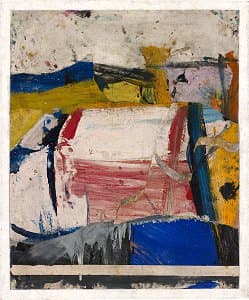

Willem de Kooning
Learn moreJuly 4th 1957
© The Willem de Kooning Foundation, New York. ARS/Copyright Agency Purchased 1972
More detail | PermalinkThe image of woman that had been the primary subject of Willem de Kooning’s paintings from 1950 gradually began to dissolve into the landscape. By 1955, the women had virtually disappeared, subsumed and replaced by gestural abstractions inspired by the forms of the urban landscape. These paintings, typically made with small, tightly-knitted shapes in strong primary colours, teem with horizontal and vertical marks. Those that follow show the shift of interest from city to countryside that climaxed in de Kooning’s decision to move to Springs, East Hampton, in 1961. While still living in New York, de Kooning had taken to painting occasionally in the country, often staying at the home of his brother-in-law, a house that de Kooning eventually purchased himself.[1]
De Kooning’s paintings of 1957, such as July 4th, mark a change from the preceding landscapes in the use of wider brushstrokes and enlarged, clarified areas that convey a sense of open spaces. The notion of rural landscape is suggested by the strong white horizontal band at the bottom of the painting, formed by the removal of tape protecting the white paper support. A number of paintings at this time were named after roadways, and Thomas B Hess has drawn attention to the way this ribbon of white suggests highway, bridge or horizon line.[2] Certainly this parallel may have amused the artist, for he rarely allowed so strong a feature to remain unaltered in his work. No doubt this is also because de Kooning used small paintings on paper as a test bed for new ideas and accidental effects that could be incorporated into larger works. July 4th itself is built from pre-existing work; a single sheet of paper painted in oil paint is overlaid with torn pieces from another crustily painted sheet, then trimmed back to the sheet size.
De Kooning had perfected this collage approach over the previous decade. Often he would overlay sections of his paintings with drawings, incorporating them into the work, or trace areas of a work to use at a later stage. Collage allowed him to test a variety of solutions to painterly problems, each alternative on paper provoking new effects or inspiring further possibilities. De Kooning fully capitalised on the breaks in continuity of the painted surface generated by the addition or subsequent removal of collaged elements. The white strip produced by the removal of masking tape at the bottom of July 4th is a crude but startling example of this. Adding elements of an existing painting on paper on the upper half of the work produces dramatic elisions that break up the image to create new structures. Photographs of the artist in 1959 show similar painted fragments tacked together in a happy arrangement on the studio wall. July 4th initially had the sculptural facility of this loose construction, but was flattened and glued down by Elaine de Kooning to facilitate mounting and framing.[3] Like other paintings titled with calendar references made during the 1950s, the title refers to the date of completion.
Michael Lloyd and Michael Desmond[4]
[1] De Kooning‘s brother-in-law, Peter Fried, had moved to Springs in 1955.
[2] Thomas B Hess, ‘Four pictures by de Kooning at Canberra’, Art and Australia, vol 14, nos 3/4, January–April 1977, pp 289–96.
[3] As above, p 295.
[4] Adapted and updated from Michael Lloyd and Michael Desmond, European and American Paintings and Sculptures 1870–1970 in the Australian National Gallery, Australian National Gallery, Canberra, 1992, pp 260–2.

